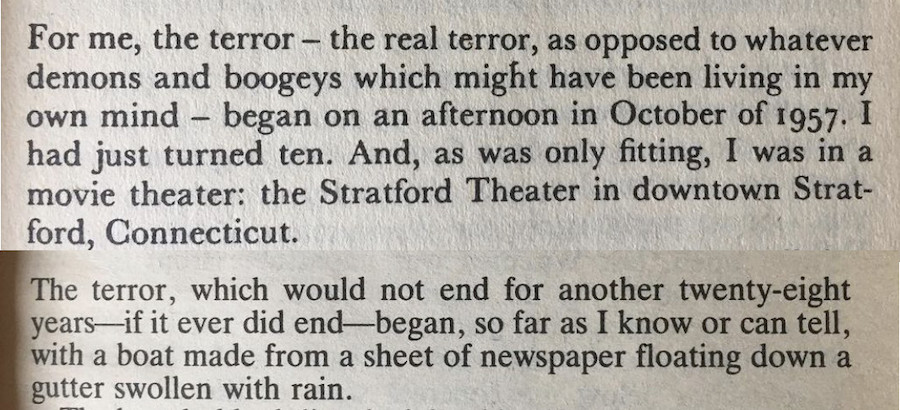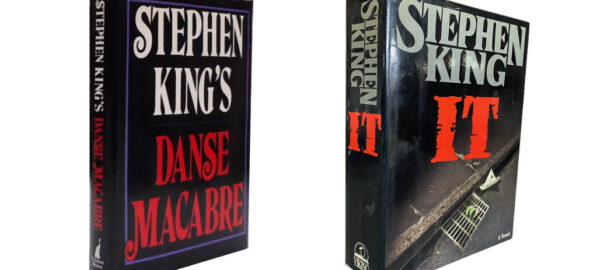King wrote the first draft of IT between August 1980 and June 1981. Before putting the first sheet into his typewriter he had been developing his ideas for IT for about five years, as he told The Bangor Daily News in July 1980.1 King did not take notes or write outlines or character studies beforehand; all that work went on in his head.
Another project, begun in 1978, heavily stimulated his preparatory thinking about IT, so much so that the two texts can be seen as two sides of the same coin. The project became King’s first novel-length work of nonfiction, Danse Macabre, published in April 1981 by Everest House. He wrote the first draft in 1979, did an extensive rewrite of the text in the spring of 1980 in preparation of submission, and turned his attention to IT immediately afterwards.
The idea for Danse Macabre originated with King’s former editor, Bill Thompson. Thompson phoned King in November 1978 and asked, “Why don’t you do a book about the entire horror phenomenon as you see it? Books, movies, radio, TV, the whole thing”.2 The timing was fortuitous, because it overlapped with the work King was doing as a writer-in-residence at the University of Maine at Orono at the time, where he taught a course called “Themes in Supernatural Literature”. King liked the idea because it would allow him to formulate an answer to many of the questions he was so often asked: Why do you write horror? Why do people read horror? The book would be his “Final Statement on the clockwork of the horror tale”.2
The research and contemplation over the next year-and-a-half for his nonfictional Final Statement influenced and complimented his ideas for IT, which he envisaged during that gestation period as a long novel inspired by the folk tale “The Three Billy Goats Gruff”: the troll under the bridge would become a monster under a city; the goats crossing the bridge he saw as a metaphor for how every child needs to cross the bridge to adulthood and face the troll underneath.
I started thinking that I’d like to write a really long book, an out-and-out horror novel, with a guy something like me at the center of it. I thought of it as my final exam on all those questions I was being asked, a kind of SAT of grue, where — if I was good — I could answer all the questions, once and for all.3
Remarkably, King’s writing of a nonfictional Final Statement on the horror genre served as preparation (revision, one could say) for his fictional Final Exam as a horror writer, which he undertook directly after Danse Macabre was submitted. The two books approach the same subject from different directions — one is coming from the head, the other from the heart.
The connection is cemented from the start, as King mirrored the opening sentences. Danse Macabre starts: “For me, the terror — the real terror, as opposed to whatever demons and boogeys which might have been living in my own mind — began on an afternoon in October of 1957”. The then ten-year-old Stephen King was at a movie theatre for a matinee showing of Earth vs. the Flying Saucers. The manager interrupted the movie to break the news that Russia had successfully launched Sputnik 1. King remembered how it had terrified him that Russia had beaten the US into space: “For me, it was the end of the sweet dream…and the beginning of the nightmare”.2
The first sentence of IT is: “The terror, which would not end for another twenty-eight years — if it ever did end — began, so far as I know or can tell, with a boat made from a sheet of newspaper floating down a gutter swollen with rain”. For Bill Denbrough, the protagonist, the terror also began when he was ten, in October of 1957, when his younger brother was violently murdered.

This is the first of numerous striking similarities between the texts. King’s preparation in 1978 and ’79 can be said to have served for both books, and that the genesis of Danse Macabre overlaps with, interacts with, and can even be said to form a part of the genesis of IT.
In Danse Macabre King writes about growing up in nineteen-fifties America:
It was a decade when every parent trembled at the spectre of juvenile delinquency: the mythic teenaged hood leaning in the doorway of the candystore there in Our Town, his hair bejeweled with Vitalis or Brylcreem, a pack of Luckies tucked under the epaulet of his motorcycle jacket, a fresh zit at one corner of his mouth and a brand-new switchblade in his back pocket, waiting for a kid to beat up, a parent to harass and embarrass, a girl to assault, or possibly a dog to rape and then kill… or maybe vice-versa”.
King is describing a stereotype that has become a staple of popular culture, but he is undoubtedly also writing from personal experiences with such bullies in his own childhood. In IT, he subsequently created a fictional character, Henry Bowers, who is an embodiment of that exact stereotype. The straightforwardly descriptive portrait of the juvenile delinquent in Danse Macabre reads as a summary of the physical traits, habits, actions, thoughts, and motivations of the fictional Henry Bowers in IT. The parallels are striking: he has the jacket, the haircut and the switchblade; he waits for and ambushes Ben Hanscom and uses the pocket knife to carve an “H” into Ben’s belly; he poisons and kills Mike Hanlon’s dog; he assaults the adult shopkeeper of the Costello Avenue Market and breaks Eddie Kaspbrak’s arm; and in chapter 17 Beverly Marsh, although she doesn’t use the word, is justly afraid that Bowers will rape her if he catches her by herself in a secluded area.
Because of the five years between their publication dates, Danse Macabre and IT are never discussed in tandem in King criticism, but for King they were interconnected products of the same period of creative reflection on “the clockwork of the horror tale”, which he loved so much.
- 1.Platt D. Novelist Stephen King to Live Winters in Bangor. The Bangor Daily News. July 3, 1980:23.
- 2.King S. Danse Macabre. Futura; 1988.
- 3.King S. IT. Cemetery Dance; 2011.
